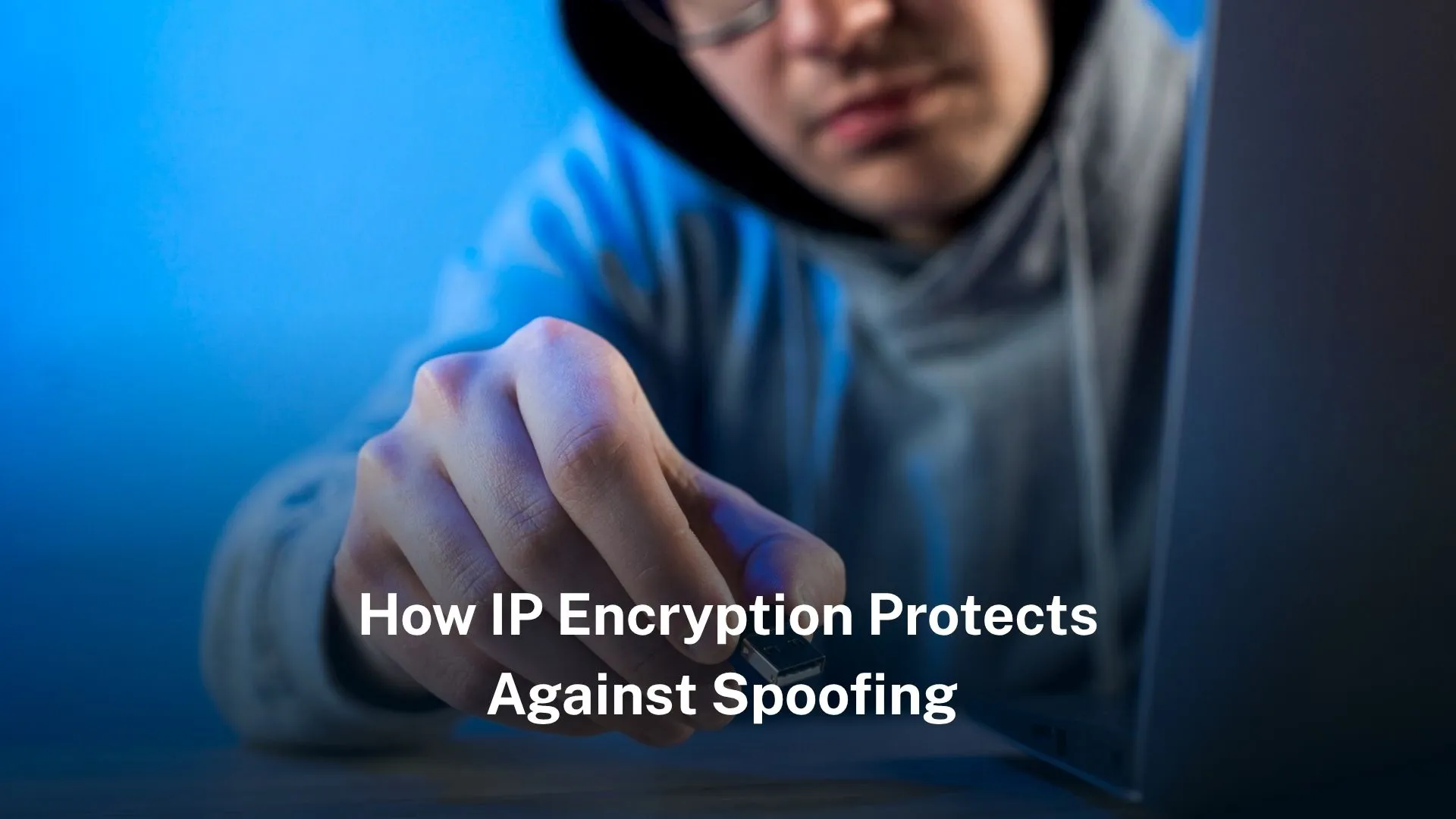IP spoofing is a big problem in cybersecurity. It lets attackers hide who they are by changing the source IP address of packets. This means they can do bad things like DDoS attacks or man-in-the-middle attacks without getting caught easily.
The threat of IP spoofing
IP encryption is a good way to stop IP spoofing. It works by making IP addresses secret so bad people can’t read or change them. One way to do this is with something called IPsec. IPsec encrypts data packets, which means it makes the information inside the packets secret. Only devices that are allowed to can open and read the packets. Even if someone catches a packet, they won’t be able to understand what’s inside because it’s encrypted. Encryption Consulting says that encryption keeps the contents of packets safe even if they are intercepted.
How IP encryption works
IP encryption helps stop IP spoofing.Attackers can’t read or change IP addresses when they are encrypted. Protocols like IPsec do this job. IPsec makes data packets secret. Only devices with permission can open and read the packets. If someone catches a packet, they can’t understand it because it’s encrypted. Encryption Consulting says that even if a packet is caught, its contents stay safe.
The role of IPsec in IP encryption
IPsec, which stands for Internet Protocol Security, is a set of rules made to protect IP communications. It works at the network layer. It gives end-to-end encryption. This means the data stays secret and can’t be changed by others. You can set up IPsec in tunnel mode. In this mode, it encrypts IP addresses. When IP addresses are encrypted, it’s really hard for attackers to spoof them.
Packet filtering: A complementary measure
IP encryption is good but it’s often used together with packet filtering. Packet filtering systems like ingress and egress filters check the source IP addresses of packets. Ingress filtering stops incoming packets with fake source addresses. Egress filtering stops outgoing packets with wrong source addresses from going out of the network. Using both of these together makes network security much stronger.
Public Key Infrastructure (PKI) and authentication
Public Key Infrastructure, or PKI, is a very important tool for stopping IP spoofing. PKI uses two types of keys: public keys and private keys. These keys are used to check if devices and users are who they say they are. The private key is used to make the communication secret. The public key is used to open the secret communication. This way of using different keys for locking and unlocking makes it very hard for bad people to fake IP addresses. Kaspersky says that with PKI, only real devices can talk to each other in a network.
Network monitoring and firewalls
Watching the network all the time is very important. It helps find strange activities that might mean someone is spoofing IP addresses. Firewalls and tools that block network attacks can check if IP addresses are real and stop traffic that isn’t allowed. If you set up firewalls to say no to packets with fake IP addresses, companies can cut down a lot on the chance of IP spoofing attacks.
Best practices for IP encryption and security
Implementing robust IP encryption and security measures is essential for protecting networks from the ever-evolving threat of IP spoofing and other cyberattacks. Here are some comprehensive best practices that organizations should consider to enhance their security posture:
1. Implement strong encryption protocols
To keep networks safe from IP spoofing and other cyberattacks, companies need to use strong IP encryption and security measures. One of the best things to do is to use strong encryption protocols. IPsec is a very common protocol used to protect IP communications. It encrypts data from start to finish and checks to make sure it’s real. This keeps the data secret and stops anyone from changing it.
Companies should set up IPsec in tunnel mode. This encrypts IP addresses, making it really hard for attackers to fake them. Also, using strong encryption algorithms like AES-256 can make security even better. Dr. Steven Bellovin, a well-known cybersecurity expert and professor at Columbia University, says, “IPsec is a key part of any strong cybersecurity plan. It encrypts data and checks where the packets come from, making it much harder for attackers to spoof IP addresses.”
2. Enable packet filtering and network access control
To protect networks, companies should use packet filtering and network access control. Packet filtering is good for finding and stopping fake IP addresses. Companies need to use ingress and egress filtering. Ingress filtering stops packets coming in with fake source addresses. Egress filtering stops packets going out with wrong source addresses. Also, Network Access Control, or NAC, can keep devices that aren’t allowed from getting on the network. This helps cut down the chance of IP spoofing attacks. Dr. Richard Ford, a cybersecurity expert, says these tools are important for defence. Using them together can make networks safer from bad activities.
3. Use Public Key Infrastructure (PKI) for authentication
Using Public Key Infrastructure, or PKI, is very important for keeping networks safe. PKI uses two types of keys: public keys and private keys. These keys help check if devices and users are real. With PKI, only real devices can talk to each other in the network. This stops attackers from faking IP addresses because it checks if each device is who it says it is. Companies should also think about using digital certificates. This makes their communications even more secure.
4. Regularly update and patch software
Keeping software up to date is really important for network security. Attackers often use problems in old software to launch attacks, including IP spoofing. Companies should have a regular process for updating software. This includes operating systems, firewalls, and security tools. Updating software with the latest security patches helps close security gaps and makes attacks less likely to succeed.
5. Conduct regular security audits and penetration testing
Regular security audits and penetration testing help find weaknesses in the network and make sure security measures work well. Security audits should look closely at network settings, encryption methods, and access controls. Penetration testing simulates real attacks to find potential problems. By doing these tests regularly, companies can fix security gaps and make their overall security better.
6. Educate employees and foster a security culture
People making mistakes often leads to successful cyberattacks. It’s important to teach employees about the dangers of IP spoofing and other cyber threats. Companies should hold regular training sessions to help employees learn about phishing attacks, social engineering, and other common ways attackers get in. Also, creating a culture where everyone thinks about security can help employees stay alert and report anything that seems strange.
7. Implement Multi-Factor Authentication (MFA)
Multi-Factor Authentication, or MFA, adds extra security by asking users to provide more than one form of identification before they can access a system. This could be something they know, like a password, something they have, like a security token, or something they are, like a fingerprint. Using MFA can stop attackers from getting in, even if they fake an IP address. Dr. Paul Kocher, a cybersecurity expert, says MFA is a strong tool for better security. It makes it much harder for attackers to get in and protects against many types of attacks.
8. Use advanced threat detection and response solutions
Using advanced threat detection and response solutions is important. Tools like Security Information and Event Management (SIEM) systems and Endpoint Detection and Response (EDR) tools can help companies find and deal with IP spoofing attacks as they happen. These solutions use machine learning and artificial intelligence to look at network traffic and spot strange activities. By using these tools, companies can quickly find and stop potential threats.
9. Implement network segmentation
Network segmentation means breaking a network into smaller pieces. This helps stop an attack from spreading and makes IP spoofing less dangerous. When a network is segmented, it means that if an attacker fakes an IP address and gets into one part of the network, they can’t easily get into the other parts. Dr. David Wagner, who knows a lot about cybersecurity, says that network segmentation is a good way to defend. Keeping different parts of the network separate helps stop attacks from spreading and makes the damage smaller.
10. Monitor and analyze network traffic
Watching network traffic all the time and looking at it carefully is important to find strange activities that might mean someone is spoofing IP addresses. Companies need to use tools that can look at how traffic moves, find things that aren’t normal, and tell people in charge about possible dangers. By keeping an eye on network traffic as it happens, companies can quickly spot and deal with IP spoofing attempts.
Real-World examples of IP spoofing attacks
Real-world examples show how serious IP spoofing attacks can be. In 2018, GitHub had a big DDoS attack. The attackers used fake IP addresses to send lots of traffic to GitHub’s servers. In 2020, Google had a bad spoofing attack that created a huge amount of traffic. These attacks show why strong security measures like IP encryption and good security rules are really important.
The future of IP spoofing prevention
The future of IP spoofing prevention needs to change as cyber threats change. Using IPv6, the newest Internet Protocol, is a good idea. IPv6 has built-in ways to encrypt and check who’s sending data, making it harder to spoof IP addresses. Also, new things in AI and machine learning can make it better to watch networks and find strange activities, helping to protect against IP spoofing.
FAQs
1. What is IP spoofing?
IP spoofing is a technique used by attackers to disguise their identity by altering the source IP address of packets. This allows them to launch attacks such as DDoS and man-in-the-middle attacks without being easily detected.
2. How does IP encryption prevent IP spoofing?
IP encryption protocols like IPsec encrypt IP addresses, making it difficult for attackers to read or spoof them. This ensures that only authorized devices can decrypt and read the information.
3. What are the benefits of using IPsec?
IPsec provides end-to-end encryption, ensuring that data remains confidential and tamper-proof. It can be configured in tunnel mode to encrypt IP addresses, making IP spoofing extremely difficult.
4. How can I detect IP spoofing?
Network monitoring tools and packet filtering systems can help detect inconsistencies in IP addresses. Ingress and egress filtering can block spoofed packets, while firewalls can authenticate IP addresses.
5. What other security measures can I take to prevent IP spoofing?
In addition to IP encryption, using Public Key Infrastructure (PKI) for authentication, keeping software updated, and conducting regular network monitoring can significantly reduce the risk of IP spoofing.




